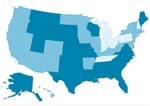Business
Getting paid for prevention: Physicians facing coding challenges
■ Promises of payment for managing chronic illness and preventing disease have doctors struggling to track and bill for both "well" and "sick" care.
By Emily Berry — Posted March 24, 2008
- WITH THIS STORY:
- » Coding Prevention Thoroughly
- » Experts' answers
- » Related content
Health insurers are offering incentives to persuade members to see doctors regularly for "well visits" and to manage chronic illnesses. Physicians know that treating an acute problem pays better and is easier to bill than prevention.
Consultants and physicians say learning how to code, bill and schedule around prevention can bolster patient care and fair payments. But doctors often struggle with insurers to ensure that coding will be recognized and that they are paid fairly.
The difficulty in documenting and billing for preventive care and sick care is encapsulated in a common situation: A patient comes in for a checkup then mentions a symptom -- shortness of breath, chest pain -- that merits its own conversation and examination. Or, conversely, the patient comes for a specific treatment, but then wants to discuss how to stop smoking or how to avoid the heart disease that runs in her family.
"It's always a challenge when doing preventive care and disease care during the same visit," said Tom Weida, MD, medical director for Penn State Milton S. Hershey Medical Center's family practice in Hershey, Pa. Doing both kinds of medicine provides an opportunity, but also a trap. If you can get reimbursed only for a sick visit or an annual exam, which do you do, and which do you bill for?
"It's so hard to do the differentiation. ... We bill for pretty much what they came in for and gift the other things," Dr. Weida said.
To help physicians parse what specific type of care they give, the Current Procedural Terminology manual includes detailed guidance about preventive visits, screenings and disease management. But often the line between sick and well care is fuzzy, leaving doctors or staffs to decide how to bill.
Dr. Weida said he faces that dilemma daily. "Say I'm seeing somebody for high blood pressure or diabetes or cholesterol, and I notice you've turned 50. Well, I'm going to make a recommendation for a colonoscopy and for baby aspirin," he said. "I don't charge a preventive [code] on that because I didn't do what I know would be considered a full preventive visit -- I tend to use the preventive codes when I've done a complete physical."
It just isn't practical to separate the two issues into two visits, he said, and it's difficult to get insurers to pay for both if they happen on the same day.
"Unfortunately, a lot of times we just bill the one code," he said. "It's just too much of a hassle. It won't be a 'clean claim.' "
Erica Swegler, MD, a family physician at North Hills Family Medicine in Keller, Texas, said sometimes getting paid means asking patients to reschedule their second priority -- their annual exam or their specific symptoms or conditions. She said she would prefer to take care of all of a patient's concerns at once but feels hamstrung by health plans' reimbursement methods.
For instance, if she noticed an unusual mole during a woman's annual pelvic exam, she might ask the patient to come back later to have the mole removed rather than try do it in the same visit. That way, she is paid for both services.
That's only fair, she said, since if the patient's ob-gyn had done the pelvic exam and sent the patient to a dermatologist for the mole removal, the insurer would have paid two bills. "Family physicians end up giving away care," Dr. Swegler said.
But sometimes, rescheduling is not an option. If a patient has a checkup but shows symptoms of the flu, or if a mother brings in a child for immunizations but the baby has an earache, the doctor hardly can tell them to come back another time.
"That's not going to endear you to patients," said physician practice consultant Andy Zarick, MD, who was a family physician in Frederick, Md., for 18 years before becoming associate director at Navigant Consulting.
Paradoxically, segregating "well" and "sick" care conflicts with the preventive "medical home" that physicians like Dr. Weida want to create for patients. "I believe in doing today's work today," he said. "Why have somebody come back two times for something I can handle in one [time] slot?"
Coding: Modifier 25
There is a coding solution for that dilemma, called a 25 modifier. But doctors say the modifier, meant to signify a distinct treatment in addition to a preventive checkup or well-visit, too often is recognized by insurers in theory only, Dr. Swegler said.
While many payers claim to recognize and reimburse for the 25 modifier, they almost all edit them out with a coding scrubber, said Cheryl Gregg Fahrenholz, president of Preferred Healthcare Solutions, a physician practice management firm based in Bellbrook, Ohio. The upshot is that doctors get paid for a preventive visit or a sick visit but not both on the same day.
A major insurer disputes that. "Our current practice is that we reimburse both a preventive visit code and a sick visit code by the same provider on the same day," said Jill Becher, spokeswoman for WellPoint.
Doctors should find out which payers claim to recognize and reimburse for the modifier, and what documentation is required. Then be meticulous about writing down everything, Fahrenholz said. That includes not only what was discussed but also why and for exactly how long -- many preventive services are reimbursed by time, she said.
Dr. Zarick said doctors should be prepared to appeal a payment decision -- and have the documentation to back it up.
A new wrinkle has emerged. Patients with high-deductible plans often have 100% coverage for preventive care, which gives them an incentive to pack all their medical issues into an annual exam.
Scheduling a follow-up visit becomes not only a time issue but a financial one, as the patient will have to pay for the next visit, and the doctor will have to try to collect the charge.
Dr. Swegler said patients have scheduled preventive visits and come with specific complaints they want treated, without having to pay out of pocket. "It sort of puts you in this uncomfortable place." She tells patients, "That's a different sort of visit; we don't have time today to do those things." She reschedules and makes clear that she must bill specific treatments outside the annual exam covered by their plan.
James Little, MD, a doctor with Portland, Ore.-based ZoomCare clinics, said the group tries to cater to patients with high-deductible plans by posting online and on-site prices for patients paying out of pocket. The clinics, located in upscale shopping centers, tout their services as "health care on demand." The clinic offers incentives for patients to pay up front and in cash, so the tangle of coding and billing insurance can be avoided, he said.
"We tell patients what it will cost before they're seen," Dr. Little said. "That's really for people with high-deductible health plans. They're one of our key demographics."
Dr. Little said physicians in the group don't hesitate to ask patients to schedule a second appointment and offer online same-day scheduling.
Pay-for-performance is theoretically a great way to be paid for good medicine: managing chronic disease and preventing potentially deadly conditions. But many physicians still are only reading about P4P -- not participating in it.
Physicians who aren't yet on board need to take the first step of learning to track and document their work managing patients with chronic illnesses, Dr. Zarick said.
"Most of us are doing the work, providing preventive counseling, but we tend to forget to document it. The disconnect is mostly because we spend so much time taking care of our patients we frequently forget documentation. ... Physicians see paperwork as a necessary evil."
But if it's done right, tracking and documenting the care and monitoring of chronic disease -- such as when you measure diabetic patients' blood glucose levels -- can improve care, Dr. Weida said.
His department's family physicians have improved their management of diabetic patients dramatically with a P4P program done in cooperation with the center's endocrinology department, he said.
"Not enough providers are collecting the quality data," Fahrenholz said. "Five years from now, all reimbursement will be based on quality indicators." Though less than half of physicians participate in P4P, "It needs to not be ignored."












